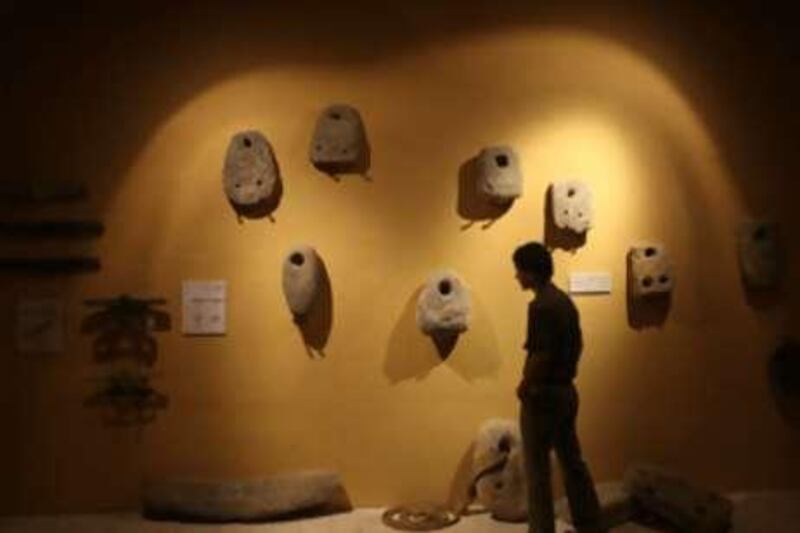NORTHERN GAZA // Drive north along the beach from Gaza City and continue through the tumbling structures of Beach Camp, the refugee camp that is home to Ismail Haniyeh, the Hamas prime minister. Another 10 minutes along the coast, past the abandoned project that would have been the luxury Movenpick hotel and just before the plots of land in Sudaniya that Gaza's middle-class are busy buying up in the hope that one day they can build villas there, lies Gaza's only archaeological museum, indeed only museum, the Mathaf.
In many ways the Mathaf is both an anachronism and a long overdue addition to Gazan life. It is an anachronism, because in this impoverished and war-torn strip of land, home to 1.5 million people, under an Israeli and international siege that still prevents all but the most essential goods from entering, the last thing one would expect to find is a brand new museum. It is long overdue because Gaza is, or ought to be, one of the most exciting destinations anywhere for any archaeologist. Located on the ancient trade routes between East and West, Gaza was a strategic port of enough importance to be registered on a 6th century mosaic floor depicting a map of the world found in Madaba, Jordan. The armies of the Egyptians, Greeks, Assyrians, Byzantines, Muslims, Ottomans and Crusaders all fought here. It is a rich history that ensures that plenty of treasures remain to be discovered.
"Dig down anywhere," said Hisham al Haj, the public relations manager at the Mathaf. "You'll find something." The Mathaf is the project of one man, Jawdat Khodari, an amateur collector and wealthy local businessman who made his fortune in construction. Indeed, many of the exhibits inside the cool air-conditioned and purpose-built hall that houses the collection are his, and were found on construction digs.
"We have to understand our roots and know that we had a long history of civilisation in Gaza," said Mr Khodari. "We have to educate our people about their deep connections to this land." It is a small but rich collection, spanning an enormous length of time from Early Bronze Age pots - some 4,000-5,000 years old - through Hellenic oil lamps, Roman seals, some impressive Byzantine columns all the way up to the recognisable Islamic-patterned tiling.
With a view to Gaza's port status and seafaring history, the exhibit opens with a collection of anchors, the earliest of which dates back several thousand years, the newest a mere 80 years old, all of them found off the shore of Gaza. "Fishermen brought these in over time," said Shireen Tarfish, the Mathaf's young curator and an archaeology student, who said Gazans had reason to be thankful that some have been preserved.
"Gaza is poor and overcrowded. It's almost impossible to control what is found and what happens to it," she said. Most of the ancient coins found in Gaza of which there must still, bearing in mind Gaza's status as a hub of trade, be plenty, she said, had been sold, usually to Israeli collectors. Indeed, the Israel Museum in Jerusalem has a large Gaza exhibit itself, a collection that Gazans have an ambivalent attitude to.
"It's our history," said Mr Haj. "Much of it was stolen by Moshe Dayan [the former Israeli chief of staff and minister of defence who had a penchant for ancient artefacts]. But at least it has survived." The buildings of the Mathaf, meanwhile, are carefully conceived. The hall housing the collection is made of stones from old houses, wood from old railroads as well as parts of columns found in Gaza. It all gives the room a sense of purpose and provides a perfect space for the collection.
"The building should match its content," said Mr Khodari, who himself collected the stones and wood that went into the hall. The siege, too, meant there was a "lack of raw materials, too many problems", but Mr Khodari seemed to have relished the challenge. "Sometimes, to work under pressure and with obstacles? it's not so bad." The roof of the main entrance hall that separates the exhibition space from the adjacent restaurant and coffee shop is covered with copper panels decorated in Islamic patterns. The restaurant and garden affords an unspoiled view of the sea and there are plans to build a hotel here as well.
In all, the Mathaf is much more than a museum, and attendance figures reflect that. Mr Khodari estimates that the complex has been visited by some 200 people a day since it officially opened on Aug 18. Ultimately, he hopes it will serve as an eye-opener for Gazans. "We have to educate people about the importance of history, of objects and of heritage. I hope this museum will encourage people to take care of their history, not throw away what they find or sell it to just anyone."
okarmi@thenational.ae





